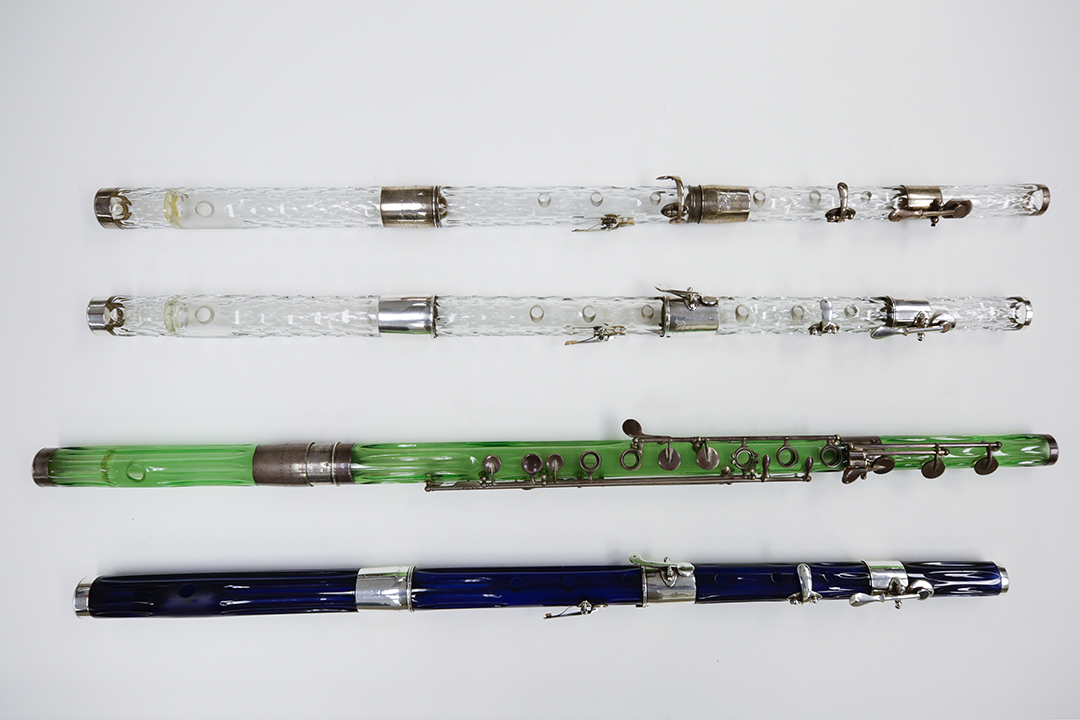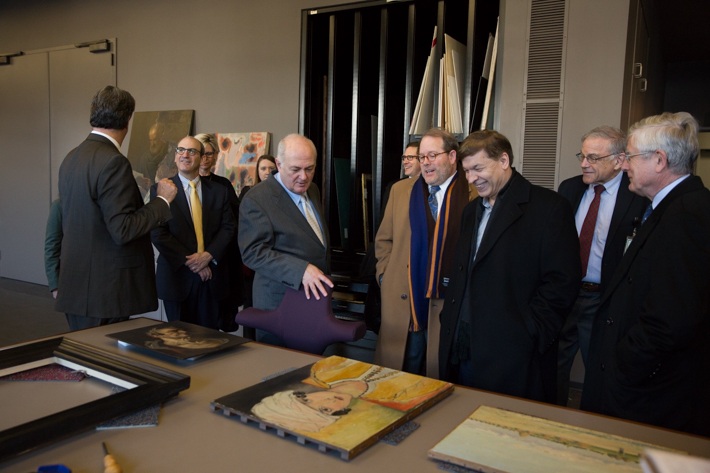By Kristen Mitchell
We typically think of glass as a stable material that doesn’t change with time, but the truth is much more complicated. Glass doesn’t last forever—and the endless possible recipes for glass developed over thousands of years can pose a challenge for modern conservators trying to preserve history.
School of Engineering and Applied Science Professor Murray Loew, an expert in medical imaging and image analysis, has been working on a project that aims to save rare historical flutes from deterioration and improve preservation guidelines for historical glass.
The National Endowment for the Humanities (NEH) awarded Dr. Loew and his research partners at the Library of Congress and Catholic University a three-year grant in 2017 to research historical 19th century glass. The interdisciplinary team is developing a decision tree that will help conservators at museums across the country effectively evaluate the condition of glass artifacts, since symptoms of deterioration are often described with vague, undefined words like “weeping” or “crizzling.”
“Different people will look at the same piece of glass and define it differently, so one of our goals is to provide objective, reproducible measures that can describe the glass as it ages,” Dr. Loew said.

Carol Lynn Ward-Bamford, a curator with the Library of Congress, prepares a flute separated into sections for CT imaging at GW Hospital. (Photo provided by Murray Loew)
The not-so-crystal flutes
Claude Laurent, a 19th century inventor who lived in Paris, designed the glass flutes at the center of this project. In 1806, he patented a design for flutes made out of “crystal,” which today we would call leaded glass. At that time flutes were primarily made out of wood and ivory, which would crack and change tone with temperature and humidity fluctuations. Musicians craved the kind of consistent sound the crystal flutes created, Dr. Loew said.
Laurent’s crystal flutes were highly refractive glass, which made them sparkly and beautiful, even before he added his signature artistic flair and jeweled keys. These alluring flutes were owned by the elites of the day and have become coveted collectors' items over the past 200 years. The Library of Congress has several, including one gifted to President James Madison.
A few years ago a concerned curator at the Library of Congress noticed that in her more than 20 years on the job, the Library’s flutes had changed slightly. She had an X-ray elemental analysis done and determined that not only are many flutes degrading, but that these are made from potash glass, a less stable and lower quality glass than the crystal Laurent had patented.
“We don’t know why Laurent substituted potash glass, a potassium silicate glass; we think he might have been trying to save money, we’re not sure, we don’t want to cast aspersions on his character, but we’re pretty sure it would have been less expensive,” said Lynn Brostoff, a research chemist at the Library of Congress and project collaborator.
This finding is a significant discovery in the conservation world, and it has raised important questions about the condition of historical glass and preventing or slowing destabilization. This challenges conservators to think about how they could best analyze the condition of glass objects without taking samples and causing further damage.
Word had gotten out in the tight-knit art world that a George Washington University imaging expert was dipping his toes into art conservation through a collaboration with the National Gallery of Art. When he heard about the flutes, Dr. Loew joined researchers to use non-invasive imaging methods to learn about their condition beyond what the eye could see.
Since the grant was awarded, the team has done ultraviolet and X-ray imaging on the glass flutes and on aged replicas created in a Catholic University lab. By using the entire light spectrum for both imaging and chemical analysis, researchers will be able to collect as much information about the flutes as possible. Most of the analysis has been done at the Library of Congress to avoid moving the valuable flutes, but last year researchers brought some of the flutes to GW Hospital for a CT scan.
The team has also analyzed a Laurent flute donated by a prominent New Jersey collector for study. This included bringing the flute to GW’s optical coherence tomography lab, where researchers are creating 2D and 3D images of the glass surface. This technique is most commonly used by ophthalmologists.
Improving conservation
In small community museums and historical societies across the country, there are boxes of artifacts that sometimes sit untouched for generations. Small budgets and space restrictions often force many interesting items into storage for long periods.
The tools that will be published at the end of this project are designed to be useful for conservators and curators at all institutions—not just those with the kinds of resources available to the Library of Congress. Developing inexpensive and accessible methods to evaluate historical glass is a priority for the research team.
“We’d like to have a way that somebody who doesn’t have any equipment, or very little, could get some preliminary understanding of their glass,” Dr. Loew said. “It would be good to be able to sort your collection into OK and at-risk, and the NEH would like them to be able to do it at minimal cost.”
The researchers have developed an effective “decision-making” tool for evaluating glass flutes. They are also working on how to assess photographic glass, such as was used during the Civil War era. Better tools will help caregivers of historical items assess their collections when “every penny is being stretched,” Dr. Brostoff said.
“We can scan one flute, but that’s a one-off here or there,” she said. “It’s worth it for people to spend a lot of time on a Picasso or another famous work, but the reality is that most people just don’t have the personnel or the budget to do much.”




